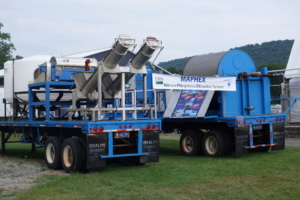Researchers at Penn State University and the US Dept. of Agriculture’s Agricultural Research Service (ARS) have developed a new technology that removes phosphorous from manure, which could have a huge impact on water quality issues.

Image: Hristov Research Group / Penn State
The system is called Manure Phosphorous Extraction (MAPHEX for short) and uses a three-stage process to treat the waste located in storage tanks or manure pits on dairy farms. First, liquids and solids are separated with an auger press and centrifuge. Then, iron sulfate is used to chemically treat the waste, and finally, diatomaceous earth is used to filter the substance.
The system was designed to be mobile, and it fits on two large flatbed trailers, which makes it usable for small and medium sized dairy farms. In the future, the system could be scaled up to a stationary system.
Removing phosphorous from manure could be a huge win for water quality, as nutrient pollution causes eutrophication, leading to dead zones throughout the Chesapeake Bay.
While this new technology is promising, it has a high operating cost. Diatomaceous earth is expensive, although scientists are looking for ways it can be recycled. They are also looking into a substitute for the expensive filtration stage, like a second centrifuge. The current system would cost about $750 per cow per year, making it unrealistic without government subsidies or increase regulations.
This technology could potentially be used on pig and chicken farms as well, which could have even bigger impacts for the Bay. In 2010, manure from dairy farms made up 20% of all phosphorous in the Bay, so MAPHEX has the potential to dramatically decrease nutrient pollution in the watershed.
Original article from Feedstuffs
